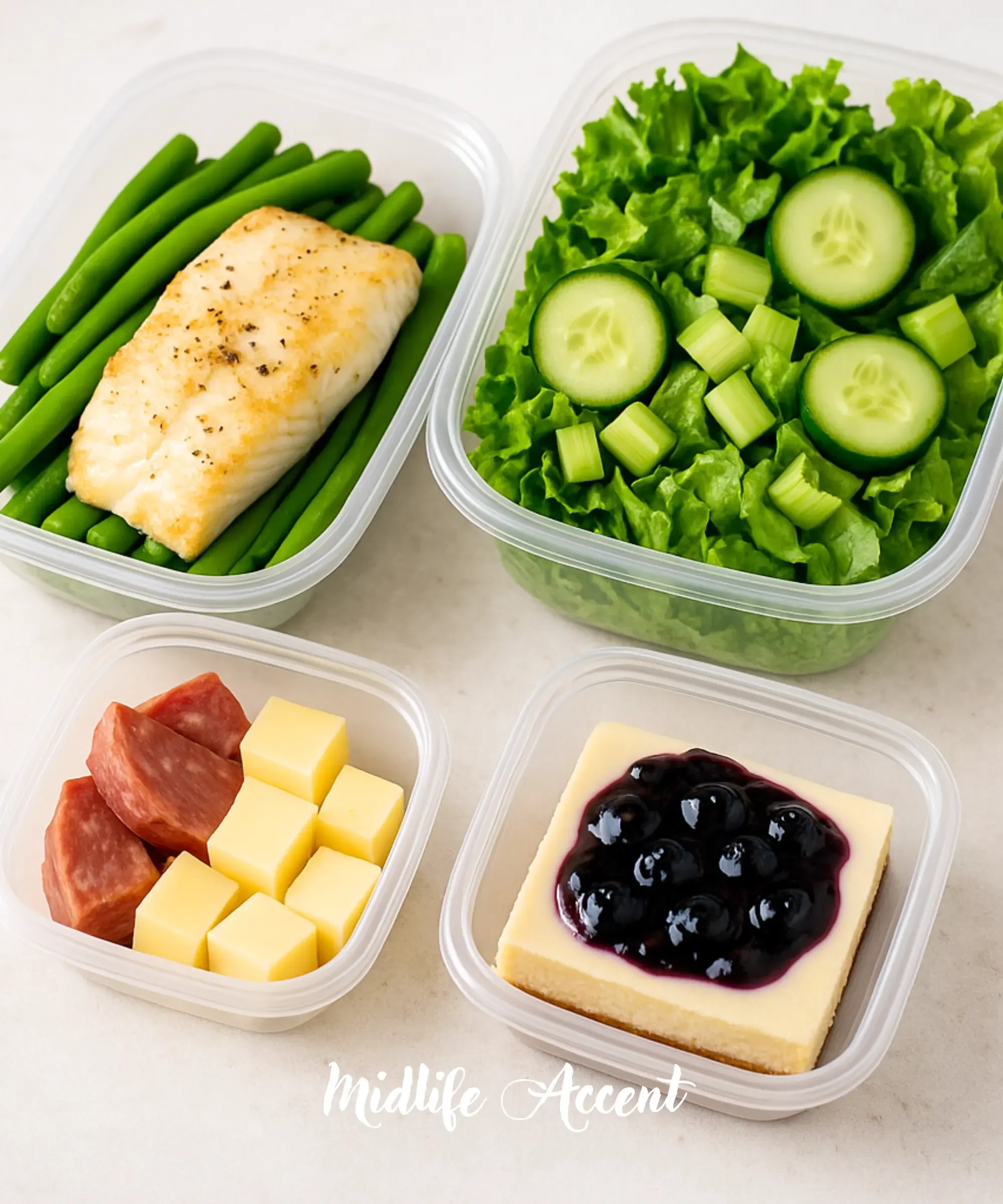A Full Day of Low-Carb Meals for Type 2 Diabetes
The First Question Everyone Asks
When my husband was diagnosed with type 2 diabetes, we made a bold choice: no prescription medication—we wanted to see what real food and lifestyle shifts could do first. (You can catch the full backstory here.)
Since I’d been eating low-carb for years, our kitchen didn’t need a total overhaul, but his routine changed fast. The bread basket disappeared, pasta nights faded, and sugary treats became history.
These days, his plate looks like mine: colorful veggies, healthy fats, and desserts with zero sugar—but plenty of joy.
Real Food, Real Results
Together, we’re proving that we can enjoy a full day diabetes-friendly diet. Low-carb meals taste amazing and help blood sugar stay steady. Our mission is simple: remission through real, nourishing food.
This post is a simply a peek into one day in our real kitchen, with meals that help keep his blood sugar steady while still feeling like food worth looking forward to.
Why Cook Low-Carb for Type 2 Diabetes?
Here’s the simple truth: carbohydrates break down into glucose, and for someone with diabetes, that can send blood sugar on a wild rollercoaster ride.
By dialing back the carbs and pairing them with protein, fiber, and healthy fats, we’ve watched my husband’s readings settle into a steady rhythm. His energy lasts longer, too—no more mid-afternoon crashes that leave him foggy and frustrated.
And honestly? It’s never felt like deprivation. It’s felt like discovery. We’ve found recipes that are naturally satisfying, surprisingly easy to make, and yes… sometimes delightfully indulgent. Low-carb doesn’t mean joyless—it just means smarter choices that your body actually thanks you for.
For more swap inspiration, I’ve shared my go-to list in 10 Low-Carb Foods Every Woman Should Eat for Steady Blood Sugar.
“Why Two Meals a Day Works for Type 2 Diabetes”
These days, my husband eats just two meals a day—right alongside me. I’ve been practicing intermittent fasting for seven years and love how steady and focused it makes me feel, so it was a natural shift for him to join in.
His first meal is around 11:30 a.m., and dinner happens at about 5 p.m. when he gets home. There’s no all-day grazing anymore. If he wants a snack, it happens right after a meal, usually with a little dessert that doesn’t mess with his blood sugar.
Each plate has plenty of protein, fresh greens tossed in my homemade dressing, a side of optional steamed veggies, and something sweet that keeps things joyful and balanced.
Our goal is simple but powerful—to bring his diabetes into remission without relying on medication, just real, nourishing food. We want to give every organ a chance to exhale after years of wear and tear from the standard diet he’d followed for too long.
“Morning Meal Prep for Type 2 Diabetes”
If you’re managing type 2 diabetes with low-carb meals, mornings can feel overwhelming. That’s why we keep things simple with a daily veggie prep I lovingly call “chop-chop time.”
In less than 10 minutes, I fill a giant bowl with freshly chopped greens and low-carb veggies—organic romaine, arugula, cucumber, celery, onion, and whatever else is hanging out in the fridge. No dressing yet, just crisp, vibrant fuel waiting to be scooped into meals later.
When it’s time to eat, I portion out three cups for him, two for me. Done. It’s a simple system that makes healthy eating feel automatic—and honestly, it’s one of the simplest ways we’ve found to keep blood sugar balanced without overthinking every plate.
Get the Diabetic Kitchen Essential fro Free inside The Wellness Accent Vault
What to Eat in a Day with Type 2 Diabetes (Low-Carb Edition)
First meal
11:30 am First Meal:
If you’re living with type 2 diabetes (or supporting someone who is), you might know this scene well: mornings fueled by gas-station donuts, a Coke, or whatever looks good at 4 a.m. That used to be my husband’s routine.
Now, things look completely different—and the change has been life-giving. These days, he starts the morning with his supplements and one cup of Ballerina Farm Vanilla Protein (not sponsored—we tested it ourselves, and it doesn’t cause a significant insulin spike). Then he waits until 11:30 a.m. for his first meal, without a hint of hunger.
Here’s what that looks like on his plate:
🥗 Three cups of salad with my homemade dressing
🐟 A serving of protein—today it was cod with green beans
🧀 Cheese and salami as a snack
🍰 A slice of sugar-free blueberry cheesecake for dessert
We’ve been following this routine for just three weeks.
Before I deliver his meal, I check his blood sugar—it’s consistently between 117 and 124. Two hours later, it stays steady between 103 and 116. That may not be “perfect” yet, but compared to where he started—360 at diagnosis—it feels like a miracle in motion.
If you want the backstory, you can read the full post about how he was diagnosed. And if you’re looking for more, my collection of low-carb comfort meals might help you build a rhythm that works in your own kitchen.
💡 Side note: I drizzle most of our meals with a creamy, tangy, low-carb dressing I make at home—so good my husband actually looks forward to his salads. Want the recipe? It’s inside my Freebie Vault—grab it free by signing up below.
What to Eat for Dinner on a Low-Carb Diet
His dinner
5:00 pm Dinner Time
Eating dinner earlier truly makes a difference. When we finish well before bed, sleep is deeper, calmer, and our bodies actually get to rest—no late-night organ overtime.
The trick is balance: healthy fats at dinner keep hunger away, so snacking isn’t tempting later. Tonight’s plate? Mashed cauliflower, beef, crisp salad with my homemade dressing, and a repeat appearance of blueberry cheesecake (because some desserts deserve an encore).
And here’s the real fundamental change: a 30-minute walk after dinner. It helps keep blood sugar steady. Longer walks happen on weekends—what counts is consistency, not perfection.
Grab your free Diabetic Kitchen Essentials Guide and make healthy eating simple, delicious, and blood-sugar friendly.
Type 2 diabetes doesn’t have to be a lifelong sentence. Indeed, sugar and refined carbs can be harmful—but the right changes can restore balance.
Intermittent fasting, cutting sugar, and focusing on real, nourishing foods have helped many people bring their blood sugar back into harmony—some even putting type 2 diabetes into remission naturally. No meds. No side effects. Just more energy, clarity, and hope.
I share our journey because it’s living proof that small, consistent changes bring about big transformations, not just recipes and routines.
Of course, everybody is different, and results can vary. You can read more about our personal experience in How We Reversed Our Type 2 Diabetes in Just Two Weeks—No Medication, Full Success.
But in the end, it comes down to a choice: a healthy, vibrant life with your family… or the fleeting pleasure of food while living with diabetes. Not everyone is willing to make that trade, and I talk about this more in The Hardest Part of Reversing Type 2 Diabetes Isn’t the Diet.
A New Chapter Starts in the Kitchen
My husband traded sugar for health, cravings for energy, and gas-station donuts for real meals—and he hasn’t looked back. Just three weeks in, his blood sugar is steady, his energy is up, and our kitchen proves that healthy can still be delicious.
And here’s the best part: you can do this too.
If you’re looking for guidance, encouragement, and recipes that keep blood sugar balanced, join me inside The Journey to Balance 💌—because no one should walk this path alone.
Quick note: I’m not a doctor—just sharing what’s been working for us. Everyone’s body is different, so please talk to your healthcare provider before making any big changes to your diet, fasting routine, or diabetes plan.
Some of my links may be affiliate links, meaning I may earn a small commission—at no extra cost to you—if you decide to purchase. I only share products I genuinely use and love. Your support keeps this content free, so thank you!




